What it’s Like To Live in Lo de Marcos, Nayarit, a Little Seaside Village About an Hour North of Puerto Vallarta
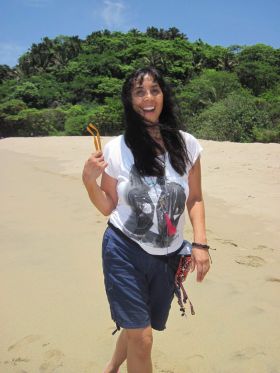 We had loved our six weeks in the little coastal village of La Ventana, in Baja California Sur, on the Sea of Cortez. Now, as our tour continued, we would have the opportunity to experience another little village, Lo de Marcos, in Nayarit, about an hour north of Puerto Vallarta, on the Pacific Ocean. While Baja was majestic, with mostly barren, expansive landscape, harder edges, and gorgeous contrasts, Lo de Marcos was vivid, infused and saturated with color. In Lo de Marcos even the air was thicker and carried with it the smells of the jungle. Lo de Marcos had a more obvious density of life than Baja. Baja had vast emptiness to appreciate, punctuated with stunning vistas, while Nayarit was filled in.
We had loved our six weeks in the little coastal village of La Ventana, in Baja California Sur, on the Sea of Cortez. Now, as our tour continued, we would have the opportunity to experience another little village, Lo de Marcos, in Nayarit, about an hour north of Puerto Vallarta, on the Pacific Ocean. While Baja was majestic, with mostly barren, expansive landscape, harder edges, and gorgeous contrasts, Lo de Marcos was vivid, infused and saturated with color. In Lo de Marcos even the air was thicker and carried with it the smells of the jungle. Lo de Marcos had a more obvious density of life than Baja. Baja had vast emptiness to appreciate, punctuated with stunning vistas, while Nayarit was filled in. Lo de Marcos is a small place. From our rental home, we were able to walk to the town square in a little more than five minutes, and to the beach in about three minutes. Even though we were only in Lo de Marcos for eight days, we got to know quite a few people by name, not only because they were friendly, but also because we saw many of them regularly.
.jpg) Lo de Marcos was even less expensive than Baja California Sur. Something that looked like a tostada that they called a volcano and was enough for an entire meal was 15 pesos (about 82 cents). A half-kilo of corn tortillas (more than a pound) was 7.5 pesos (about 41 cents). Fruit stands were everywhere along the main road to and from town. One of our favorite purchases was star fruit, which cost 5 pesos for two. In the States, one star fruit would cost more than a dollar. Here, it was about 13 cents, and even then, I believe the Mexicans may have thought they were overcharging us because, as we were told after my wife Jet asked, star fruit grew on the trees in many of their yards.
Lo de Marcos was even less expensive than Baja California Sur. Something that looked like a tostada that they called a volcano and was enough for an entire meal was 15 pesos (about 82 cents). A half-kilo of corn tortillas (more than a pound) was 7.5 pesos (about 41 cents). Fruit stands were everywhere along the main road to and from town. One of our favorite purchases was star fruit, which cost 5 pesos for two. In the States, one star fruit would cost more than a dollar. Here, it was about 13 cents, and even then, I believe the Mexicans may have thought they were overcharging us because, as we were told after my wife Jet asked, star fruit grew on the trees in many of their yards. .jpg) Personal services were cheap, sometimes ridiculously so. I got a really good haircut for 50 pesos (less than $3).
Personal services were cheap, sometimes ridiculously so. I got a really good haircut for 50 pesos (less than $3). We ate creatively prepared, very tasty, complex and fabulous food in Lo de Marcos, as well as freshly squeezed juice every day. My favorite was a green blend the ingredients of which I couldn’t make out from the Spanish-speaking proprietor of the juice stand. There was also a lot of carrot juice, orange juice, and nanche juice, which is made by putting the entire nanche fruit in a standard blender, pits and all, then adding water and a little sweetener. They put it in a big container and spoon out the juice. It has a unique and interesting taste I really liked.
Like all the beaches we saw in Nayarit, Lo de Marcos was bracketed by two hills that extended into the Pacific. The hills were completely blanketed with jungle growth, right down to the water. In between the hills was the sandy beach that, if you were walking briskly, you could span in about 20 – 30 minutes. Up from the beach was the town, which measured a 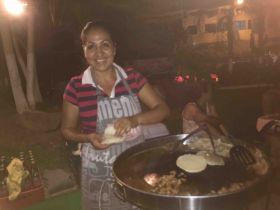 little more than half a mile from the main road to the water. The town square was roughly in the middle. That was it.
little more than half a mile from the main road to the water. The town square was roughly in the middle. That was it.
 little more than half a mile from the main road to the water. The town square was roughly in the middle. That was it.
little more than half a mile from the main road to the water. The town square was roughly in the middle. That was it. Our house was one block from the ocean on a road that paralleled the beach. I could walk onto that road facing towards the ocean, and see the hills on each side. On this un-crowded road going in either direction were people, un-accompanied dogs that walked with an earnestness that looked like they were late for an appointment, the occasional car, ATVs, and people on horses. Our realtor, Armando Contreras told us that, if we followed this road a mile or so to the south there was a very nice, secluded beach called Venado that you couldn’t get to by walking along the beach. So off I went, down the road, with our two dogs.
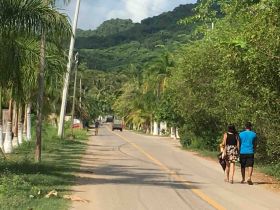 The road was flat for a while, but then began to rise as I started up the first hill. One of the advantages of walking as opposed to driving is that you enter an environment more slowly and quietly, and without the barrier provided by the windows in your car and your speed. You are much more “in” the place, rather than just “going through” it. In this state, I could see and more fully understand that the areas immediately to the side of the road looked to be in their natural state, with a profusion of jungle plants; palms, trees and vines with huge, broad leaves, all respirating in the thick, somewhat humid, warm, jungle-scented air. Standing still, I could hear distant birds squawking and the buzzing and chirping of insects. As I looked at it, it occurred to me how difficult it must have been for the first people here (the ones before the roads were put in) to get anywhere; they would literally have to cut their way through the jungle, hack-by-hack and step-by-step. Now I know why the machete was invented.
The road was flat for a while, but then began to rise as I started up the first hill. One of the advantages of walking as opposed to driving is that you enter an environment more slowly and quietly, and without the barrier provided by the windows in your car and your speed. You are much more “in” the place, rather than just “going through” it. In this state, I could see and more fully understand that the areas immediately to the side of the road looked to be in their natural state, with a profusion of jungle plants; palms, trees and vines with huge, broad leaves, all respirating in the thick, somewhat humid, warm, jungle-scented air. Standing still, I could hear distant birds squawking and the buzzing and chirping of insects. As I looked at it, it occurred to me how difficult it must have been for the first people here (the ones before the roads were put in) to get anywhere; they would literally have to cut their way through the jungle, hack-by-hack and step-by-step. Now I know why the machete was invented. 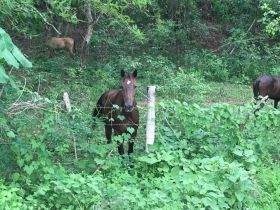
Quite unexpectedly, I came across about a dozen horses off to the side of the road, grazing in the jungle. Perhaps this would not be odd to other people, but to me, who was used to seeing horses in more scrub or chaparral territory, it was strange, indeed. The entire atmosphere, not only what I saw, but the overall feel of the environment and the quiet, idyllic nature of it, especially with the horses, gave the area a natural, innocent, “Garden of Eden” feel.
As I walked by, very modest houses partially hidden from the road by the jungle appeared sporadically, as did very impressive gates that allowed no viewpoint or entry whatsoever. The “Big Gate People” would have their paradise to themselves. Every once in a while, I could see a large house on a hill with what I could only imagine would have a magnificent, panoramic view. Back on the road, some of the homes of even the poorer 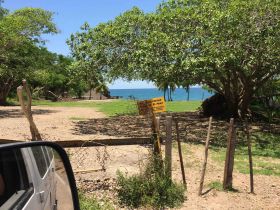 people had the equivalent of a “no trespassing” sign, the meaning sometimes amplified by the presence of several dogs. One house advertised that the owner sold popsicles, although it didn’t appear as if there would be a lot of traffic to support his business. Overall, even in the late afternoon, the road was fairly dark, owing to the huge and densely growing foliage on each side and overhead.
people had the equivalent of a “no trespassing” sign, the meaning sometimes amplified by the presence of several dogs. One house advertised that the owner sold popsicles, although it didn’t appear as if there would be a lot of traffic to support his business. Overall, even in the late afternoon, the road was fairly dark, owing to the huge and densely growing foliage on each side and overhead.
 people had the equivalent of a “no trespassing” sign, the meaning sometimes amplified by the presence of several dogs. One house advertised that the owner sold popsicles, although it didn’t appear as if there would be a lot of traffic to support his business. Overall, even in the late afternoon, the road was fairly dark, owing to the huge and densely growing foliage on each side and overhead.
people had the equivalent of a “no trespassing” sign, the meaning sometimes amplified by the presence of several dogs. One house advertised that the owner sold popsicles, although it didn’t appear as if there would be a lot of traffic to support his business. Overall, even in the late afternoon, the road was fairly dark, owing to the huge and densely growing foliage on each side and overhead. Then, off to the right side, the jungle gave way to a vista that looked like it could have been a location spot for the movie Blue Lagoon. It looked like the area right in front of the road had been cleared, so I could clearly see that this piece of land had its own, private little bay, with a white, sandy beach, gently lapping waves, and palm trees placed in just the right spots (video here). To the right of it was the relatively flat jungle. To the left, was a hill. On the land was a tiny house with bicycle in front of it, another tiny house 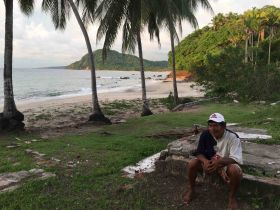 with bananas growing next to it, and in the front of the gate was a sign that said it was private property. Who could possibly own such a perfect place? And if they could afford it, why was their house so small?
with bananas growing next to it, and in the front of the gate was a sign that said it was private property. Who could possibly own such a perfect place? And if they could afford it, why was their house so small?
 with bananas growing next to it, and in the front of the gate was a sign that said it was private property. Who could possibly own such a perfect place? And if they could afford it, why was their house so small?
with bananas growing next to it, and in the front of the gate was a sign that said it was private property. Who could possibly own such a perfect place? And if they could afford it, why was their house so small? As I wondered these thoughts and took it all in for several minutes standing in front of the no trespassing sign, I saw in the distance a man coming towards me. As he came closer, I saw that he didn’t seem to be upset with me looking at his property, so I waved and eventually offered the standard “Buenos tardes.” He spoke no English whatsoever and my Spanish is limited, but I could tell that he was inviting me in, an invitation I accepted, along with my two dogs. His five dogs were curious, but he kept them away.
It turned out that he was very happy to show me his land, and was quite pleased with how much I liked it. “I liked it” is a bit of an understatement, as to me, it may have been the single most tranquil and gorgeous beach home property I had ever seen this side 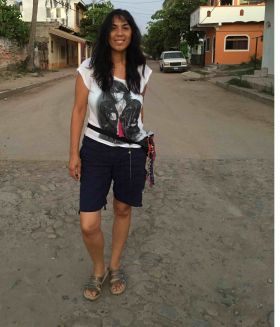 of Bora Bora. As we communicated the best we could, the sun began to set over the Pacific in front of my new friend’s little private beach, so I took a few more pictures, thanked him, and headed home. That day, I never got to the beach Armando had recommended.
of Bora Bora. As we communicated the best we could, the sun began to set over the Pacific in front of my new friend’s little private beach, so I took a few more pictures, thanked him, and headed home. That day, I never got to the beach Armando had recommended.
 of Bora Bora. As we communicated the best we could, the sun began to set over the Pacific in front of my new friend’s little private beach, so I took a few more pictures, thanked him, and headed home. That day, I never got to the beach Armando had recommended.
of Bora Bora. As we communicated the best we could, the sun began to set over the Pacific in front of my new friend’s little private beach, so I took a few more pictures, thanked him, and headed home. That day, I never got to the beach Armando had recommended. While I had found an amazing beach, Jet had found something else: what she was convinced was a huge, mangy, long tailed rat, walking on the telephone wires in front of our house. She was to see this “rat” several additional times during our stay, which is ironic, because I never saw it at all. I guess people just tend to be on the lookout for what they fear. (To see what the “rat” was, see this video, as our gardener Victor, and his wife, Rosario, explain it.)
It was hot in Lo de Marcos in July, but not unbearable. It was nice, however, to have air conditioning on demand. Like the house we stayed in at La Ventana, there was no central air conditioning like you may have in the US. Instead, they have wall units (mostly in the bedrooms), which were very efficient. Unfortunately, one of them wasn’t working, so we got to meet what eventually were three air conditioning repairmen, who could not have been nicer or more pleasant, as they struggled to fix our air conditioning while being on the roof over the period of several days. One of the reasons it 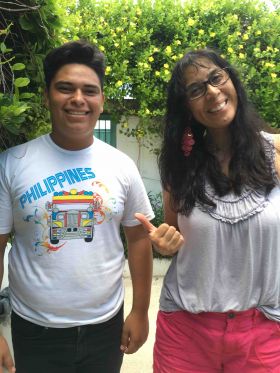 took so long was that every time they found they needed a different part, they had to drive (one of them had a motorcycle) to La Penita, which is about 10 miles in each direction. (That's one of the repairmen to the right, with Jet, wearing a very authentic t-shirt from the Philippines-- Jet's birthplace-- although he had no idea what it pictured.)
took so long was that every time they found they needed a different part, they had to drive (one of them had a motorcycle) to La Penita, which is about 10 miles in each direction. (That's one of the repairmen to the right, with Jet, wearing a very authentic t-shirt from the Philippines-- Jet's birthplace-- although he had no idea what it pictured.)
 took so long was that every time they found they needed a different part, they had to drive (one of them had a motorcycle) to La Penita, which is about 10 miles in each direction. (That's one of the repairmen to the right, with Jet, wearing a very authentic t-shirt from the Philippines-- Jet's birthplace-- although he had no idea what it pictured.)
took so long was that every time they found they needed a different part, they had to drive (one of them had a motorcycle) to La Penita, which is about 10 miles in each direction. (That's one of the repairmen to the right, with Jet, wearing a very authentic t-shirt from the Philippines-- Jet's birthplace-- although he had no idea what it pictured.) Not only is Lo de Marcos small, but it also retains it’s farming heritage in a very central way. For example, one day, on my way to get one of those great juices, I saw a cattle drive… right through the middle of the town square. No one was surprised but me.
It was in this same town square that, eight days earlier, upon our arrival, we witnessed the townspeople who were then all strangers to us dancing to the surprisingly good music of a government provided band, so it was only fitting that on our last night in this wonderful little town of Lo de Marcos, there was dancing again. This time, however, we were no longer newcomers and not all the people dancing were strangers. As we came across Victor and Rosario, Victor asked Jet to dance, which she did, thereby placing a bittersweet, bookend finale to our time there. We would love to come back.
Links to articles about what we learned on our Mexico road trip:
See links to all Mexico road trip stories below. You are currently reading the one highlighted with the yellow background.
To see hundreds of questions answered by expats already living in Mexico, click here.
To see hundreds of questions answered by expats already living in Mexico, Panama, Belize, Nicaragua and Portugal, go here and navigate to the place you're most interested in.
Sign up for the Best Places in the World to Retire newsletter. To see additional additional pictures and videos not in the stories, follow us on Facebook. To see more videos of the trip, see our YouTube channel.
Want online, interactive help finding the best place abroad for you? Try the Location Advisor.
To download free research studies conducted with over 1,000 expats currently living in Mexico, click here.
Download the free eBook of all the stories below, "Our Year on the Road & Living in Mexico-- Adventures, Challenges, Triumphs, Lessons Learned"
Links to Mexico Road Trip stories:
Editor’s note: you may freely reprint the article above, provided you put this at the beginning or end:
Content provided by Best Places in the World to Retire, which provides credible answers to questions about moving abroad, expat stories, and a location advisor to help you find the perfect place for you.
Content provided by Best Places in the World to Retire, which provides credible answers to questions about moving abroad, expat stories, and a location advisor to help you find the perfect place for you.



.png)